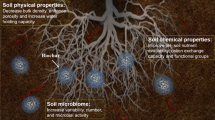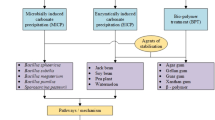Abstract
The increased cost associated with the waste removal and disposal of conventional agricultural plastic in contact with the soil combined with the gradually decreasing cost of the biodegradable plastics allowed the commercialization of biodegradable mulching films. Since the conventional thin wall or tape drip irrigation system lies under the mulching film and is used for one season only, it would be desirable to replace it with a biodegradable one. This paper presents the results of a research work investigating the possibilities and limitations in developing biodegradable drip irrigation thin wall pipes and pipes. The first ever experimental biodegradable drip irrigation thin wall pipes were produced. Rigid pipes were also produced for experimental purposes. Manufacturing problems were encountered in the processing of the biodegradable drippers and irrigation thin wall pipes with the experimental materials due to the complex formulation of the raw materials and the fact that the machinery used was specifically designed for PE processing. Experimental biodegradable thin wall pipes made of Bioflex with embedded drippers made of Mater-Bi were produced. The processing problems encountered with the production of thin wall pipes were surpassed during the experimental production of rigid type irrigation pipes. A biodegradable rigid irrigation pipe made of a grade of Mater-Bi, with embedded cylindrical drippers made of another grade of Mater-Bi was produced successfully. A better understanding of the thermal profile of the biodegradable raw materials and the use of processing equipment adapted to this profile might allow in the future the manufacturing of thin wall drip irrigation pipes for agricultural applications, and the use of alternative biodegradable materials.




















Similar content being viewed by others
References
Briassoulis D, Hiskakis M, Scarascia G, Picuno P, Delgado C, Dejean C (2010) Qual Assur Saf Crops Foods 2(2):93–104
Estermann R, Schwarzwalder B (2001) Proceedings of the 1st world conference on biomass for energy and industry, 5–9 June 2000, Sevilla, Spain, vol II. James&James Ltd., London, UK, pp 1028–1031. ISBN 1-902916-15-8
Demirbas A (2007) Energy Sourc A 29:419–424
Garthe JW, Kowal PD (2002) The chemical composition of degradable plastics. Pennstate, College of Agricultural Sciences, U.S. Department of Agriculture, and Pennsylvania Counties Cooperating, Catalog Number: C-17
Briassoulis D (2004) J Polym Envirom 12(2):65–81
Briassoulis D (2007) Polym Degrad Stabil 92:1115–1132
Scarascia-Mugnozza G, Schettini E, Vox G (2004) Biosyst Eng 87(4):479–487
Scarascia-Mugnozza G, Schettini E, Vox G, Malinconico M, Immirzi B, Pagliara S (2006) Polym Degrad Stab 91:2801–2808
APME (Association of Plastic Manufacturers in Europe) (2002) An analysis of plastic consumption and recovery in Western Europe. http://www.plasticseurope.org/. Accessed at 16 April 2009
Solaro R, Corti A, Chiellini E (1998) J Polym Environ 6(4):203–208
Kyrikou I, Briassoulis D (2007) J Polym Environ 15(2):125–150
Eurostat—Data Explorer, European Commission. http://ec.europa.eu/eurostat, Rue Alcide de Gasperi LU-2920 Luxembourg, Luxembourg Accessed at 16 April 2009
Congresso Internacional de Plasticos para la Agricultura’ (CIPA) in France for 2006
European (2010) ‘Labelling agricultural plastic waste for valorising the waste stream’, Collective research, LabelAgriWaste, Contract no. 516256-2. http://labelagriwaste.aua.gr/. Accessed at 12 April 2010
Briassoulis D, Babou E, Hiskakis M (2011) J Polym Environ 19(2):341–361
Eurodrip SA (2010). http://www.eurodrip.gr/. Accessed at 12 April 2010
Total Petrochemicals (2010) Total Lacqtene®2006 TN 35 HDPE pipe coating. http://www.matweb.com/search/datasheettext.aspx?matguid=dacb1b98898c4b2da4c251bdb76178a5. Accessed at 12 April 2010
Dow Europe GmbH (2010) DOWLEX NG 2431 NE polyethylene resin (now replaced by other grades). http://www.dow.com/polyethylene/na/en/prod/dowlex.htm. Accessed at 12 April 2010
Novamont S.p.A. (2010). http://www.novamont.com. Accessed at 12 April 2010
Comite Europeen de Normalisation EN 13432: 2000/AC:2005 (2005) European committee for standardization. EN 13432. Packaging—requirements for packaging recoverable through composting and biodegradation—test scheme and evaluation criteria for the final acceptance of packaging. European Committee for Standardisation, Brussels
Deutsche Normen DIN (1998) DIN V 54900 “Testing of compostability of plastics - Part 1: Chemical testing”, October 1998 edition; Part 2: Testing of the complete biodegradability of plastics in laboratory tests”, September 1998 edition; Part 3: Testing under practice-relevant conditions and a method of testing the quality of the composts”, September 1998 edition, DIN Deutsches Institut fuer Normung, Beuth, Koeln, Berlin
Unificazione Italiana UNI (2001) UNI 10785 Compostabilità dei materiali plastici, Unificazione Italiana, Milano
Vinçotte (2010). http://www.aib-vincotte.com/en/home/. Accessed at 12 April 2010
De Wilde B (2002) Standardisation activities related to measuring biodegradability of plastics in soil and marine conditions. 3–5 February 2002, presentation in international conference “Industrial Applications of Bioplastics” York, United Kingdom
Kapanen A, Schettini E, Vox G, Itavaara M (2008) J Polym Environ 16:2, 109–122
Briassoulis D (2006) Polym Degrad Stab 91:1256–1272
Briassoulis D (2006) J Polym Environ 14(3):289–307
FKuR Kunststoff GmbH (2010). www.fkur.com, http://www.fkur.com/produkte/bio-flex/bio-flex-f-1130/zertifikate.html. Accessed at 12 April 2010
Okada M (2002) Chemical syntheses of biodegradable polymers. Prog Polym Sci 27:87–133
Ho KL, Pometto AL, Gadea-Rivas A, Briceño JA, Rojas A (2004) Degradation of Polylactic acid (PLA) plastic in Costa Rican soil and Iowa state university compost rows. J Environ Polym Degr 7(4):173–177
Bioplastics24.comFH (2010) Braunschweig/Wolfenbüttel Standort Wolfsburg, IFR—Institut für Recycling. http://www.bioplastics24.com/content/view/71/36/lang,en/. Accessed at 12 April 2010
Kima M, Leea A, Yoonb J, Chin I (2000) Biodegradation of poly(3-hydroxybutyrate), Sky-Green and Mater-Bi by fungi isolated from soils. Eur Polym J 36:1677–1685
EN ISO 527-3 (1995) Plastics—determination of tensile properties—part 3: test conditions for films and sheets. International Organization for Standardization (ISO), Switzerland
Biomer (2010) www.biomer.de Accessed at 12 April 2010
MatWeb (2010) ‘Biomer P209 PHB Biodegradable Polymer’. http://www.matweb.com. Accessed at 12 April 2010
Kaci M, Cimmino S, Lorenzo ML, Silvestre C, Sadoun T (1999) Pure Appl Chem A36(2):253–274
Briassoulis D (2005) Polym Degrad Stab 88(3):489–503
PATI S.p.A. (2010). http://www.pati.it/. Accessed at 12 April 2010
Dintcheva NT, La Mantia FP, Scaffaro R, Paci M, Acierno D, Camino G (2002) Reprocessing and restabilization of greenhouse films. Polym Degrad Stab 75:459–464
Salem MA (2001) Egypt J Sol 24(2):141–149
Beake BD, Philip H, Shipway C, Graham J, Leggett Β (2004) Wear 256:118–125
Kampouris M, Papaspyrides K (2002) Polymer Technology/Structure-Polymer Properties, pp 78–82 (in Greek)
Jiang L, Hinrichsen G (1999) Die Angewandte Makromolekulare Chemie 268:18–21
European Commission, DG Environment (2002) “Evaluation of environmental product declaration schemes”. Final report—Annex X, September 2002. http://ec.europa.eu/environment/ipp/pdf/epdstudy.pdf. Accessed at 12 April 2010
Acknowledgments
The project was funded by the General Secretariat for Research and Technology, Greece. Thanks are due to N. Bacharidis (Eurodrip’s Project Manager for the biodegradable pipe project) and C. Bolinis (Production Manager) for the production of the pipes at the industrial facilities of Eurodrip as well as to the technical teams of Novamont S.A, FKUR and Biomer for the technical support.
Author information
Authors and Affiliations
Corresponding author
Rights and permissions
About this article
Cite this article
Hiskakis, M., Babou, E. & Briassoulis, D. Experimental Processing of Biodegradable Drip Irrigation Systems—Possibilities and Limitations. J Polym Environ 19, 887–907 (2011). https://doi.org/10.1007/s10924-011-0341-1
Published:
Issue Date:
DOI: https://doi.org/10.1007/s10924-011-0341-1




